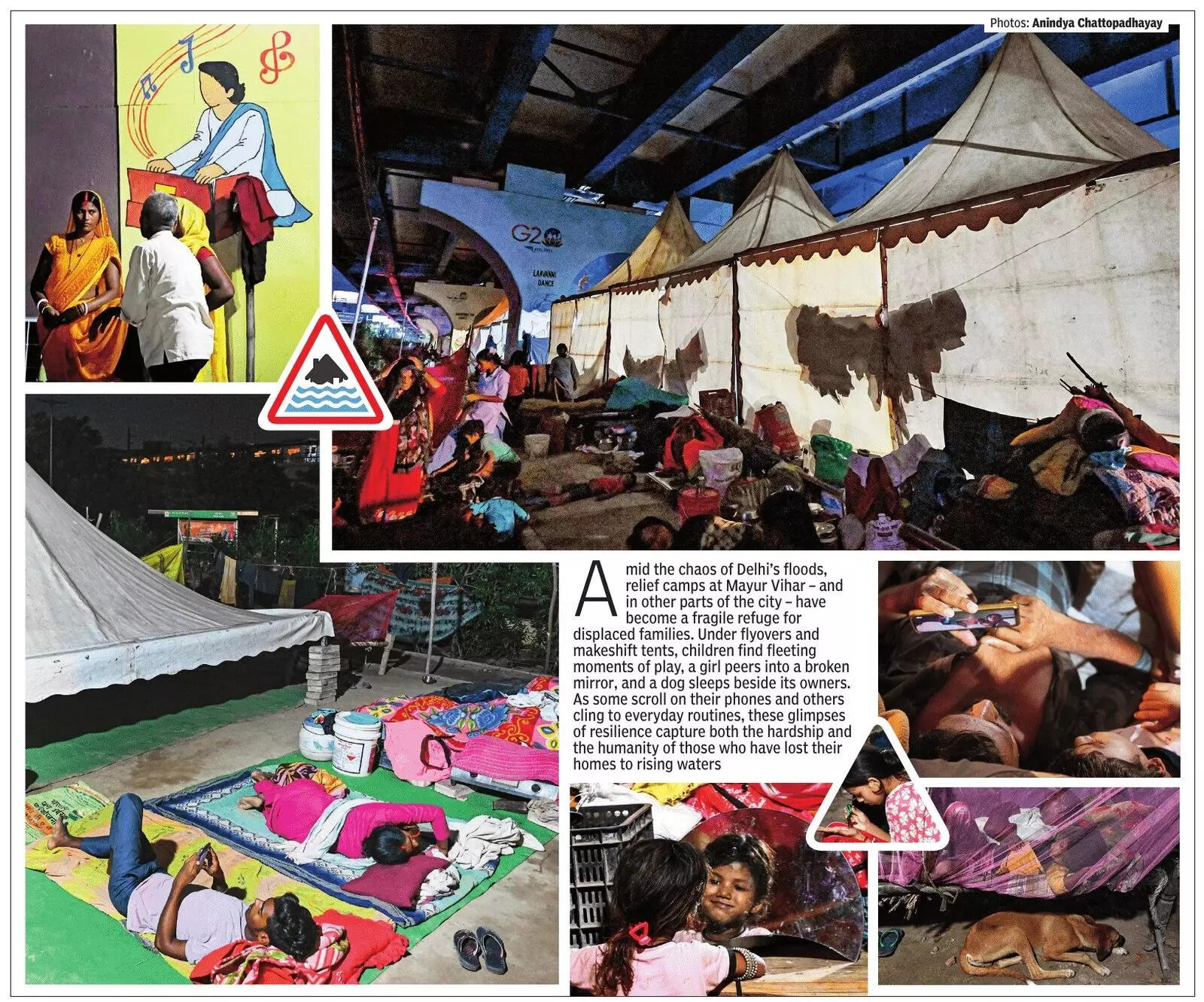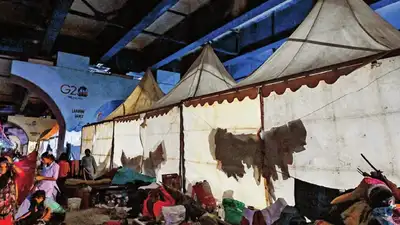For the city’s nowhere men and women inhabiting the Yamuna banks, flood and displacement are part of life’s loop that plays out annually in Mayur Vihar — where home shifts under a bridge and hope hangs by a threadNEW DELHI: In Sept 2023, Delhi was spruced up. But mostly in a shallow way. Sidewalks that didn’t need renovation were renovated. Flowerpots and fountains sprouted in unlikely places.
Marble elephants were positioned strategically. Many of the improvements carried out for the grand G20 summit disappeared in a few months. But the artwork on the pillars below the flyover near the Mayur Vihar Extension’s Metro station remains an unassuming reminder of that ambitious event. The modest paintings on the thick columns of concrete offer a bioscopic view of the city – Birla Mandir, Parliament, Red Fort – and the nation’s heroes – Subhash Chandra Bose, Bhagat Singh, APJ Abdul Kalam, among others.In the past few days, this area, normally a resting post for the colony’s vagabond cows, has been transformed into a relief shelter for the capital’s marginals who live on the low-lying plains of the Yamuna banks. Whenever the river invades the fertile fields and their pocket-size homes, they hurriedly cram their small world into aluminium trunks. What cannot be packed is carried on shoulders to the govt-run relief camps. Displacements like these would shatter most middle-class families. But these nowhere people have internalised the dislodging. Most have lost count of the nights spent over the years in such shelters.Pain is part of their monsoon calendar. The protagonists of ‘Deewar’ (1975) spent their childhood under a bridge before going away to do bigger, if not better, things. But for the people of Yamuna banks, the place below the flyover symbolises life’s endless loop of flood and displacement.This has been a particularly bad year. In the past few months, authorities bulldozed many shanties built illegally over the years on the floodplains. “They even broke our water taps,” says Puliya, an aging widow. “We can’t live there. We can’t grow vegetables. Where do we go?,” asks vegetable seller Manoj Kumar.

Many like him grew vegetables. Okra, spinach, radish — the vegetables changed with the seasons. Now the flood has taken away their homes, crops and workplace. Going back isn’t an option. “There is no work there,” he says.Most of them came decades ago from Bihar’s Saharsa and Katihar districts. Anita Devi has only known life around the Yamuna floodplains. She recalls her childhood when her family lived in the area around Akshardham temple which was inaugurated in 2005. “We belong to the mallah (boat and fishermen people) community. My father used to catch and sell fish. But he was also among the workers who built the temple,” she recalls. After the temple came up, they shifted to the other side of the road. One of her aunts (bua) was among the labourers who put together the two five-star hotels, readied after the Commonwealth Games 2010, adjacent to the Mayur Vihar flyover. Puliya too was among the labourers. “We were paid Rs 125 per day,” she says. Many women and men in the floodplains make chatais, mats made of river grass or weeds. But life is on pause these days.Govt is doing its bit. Rows of white tents have been set up on one side of the road and under the bridge, the latter a better shelter from rain. A bunch of civil defence men in yellow uniform mill about. Dal chawal is served twice a day. Blue water-tankers are stationed. So are mobile public toilets. An ambulance posted specifically for them is away on duty. “But the toilets are dirty. And there is no place to change clothes,” complains Geeta Devi, who has three teenage daughters. Premjit Singh, head of civil defence, listens patiently. “I will try to arrange for it tomorrow. Also, tea and biscuits,” he says.There are 450-odd families under the flyover: 3,700 men, women and children, including a six-day-old baby, according to an official. But the relief camp isn’t a place of gloom. Under the glow of white lights, the place bustles like a bazaar. Privacy is just a thin sari hanging from a wire. But the 10×10 feet of space is home where a pot of rice is on the boil, where a young girl is watching Sanjay Dutt serenade Juhi Chawla in the Bollywood flop, Safari, on a mobile. Adversity has taught them to be at home anywhere, even when the real home is underwater.On the other side of the makeshift curtain is a common pathway. For a bunch of men playing cards, the day disappeared fast searching for ways to negotiate the future. Now as night has settled in like a sleepy tortoise, a bunch of kids queue behind a do-gooder’s car where 200 packets of biryani are distributed. A girl applies mehndi on her palm. A stray named Badshah steps out from beneath a charpoy. Unnamed roosters, goats and buffaloes look comfortable in their corners.“I cannot sleep properly because thieves often steal goats in the dead of night,” says a man watching two men fight over “chhoti si baat”. Their women pull them away, breaking the brawl. The men sulk in their respective corners like prized boxers denied a bout. Nearby, the six-day old baby sleeps soundlessly.










